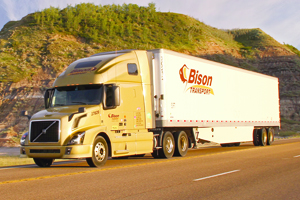Winter Conditions Are Crucial to Truck Spec'ing for Canada

This story appears in the April 11 print edition of Equipment & Maintenance Update, a supplement to Transport Topics.
As they seek to expand, many carriers eye opportunities in new markets. One potential and unexplored area for U.S.-domiciled carriers could be north of the border in Canada, but carriers must consider truck spec’ing factors to make the most of those opportunities.
“There are higher weights, higher horsepower and different weight laws,” said Mike Guarino, on-highway marketing manager for Western Star, the niche truck-making unit of Daimler Trucks North America, which traces its history to its original plant in Kelowna, British Columbia. “But for truckers heading north, the real test is meeting the climate conditions in winter.”
The winter preparation extends to the fuel in the tanks.
BEST OF APRIL E&MU: More stories, columns
“In winter, we try to buy fuel in Canada or the northern {U.S.] states,” said Mark Irwin, former director of maintenance with Winnipeg, Manitoba-based Bison Transport Inc.
The fuel from the South “is marginally treated,” and problems start to arise when you’re in minus 30 degrees Fahrenheit, said Irwin, who left Bison earlier this year after 12 years to pursue other interests in trucking.
Bob Penner, Bison president and chief operating officer, wanted Irwin to comment because of his experience with the company.
Meanwhile, Irwin said, the real difference in the spec process is dealing with temperature extremes in the Canadian winters.
“When you’re going north-south, you need automatic tire inflation and deflation,” he said.
If the air pressure of the truck’s tires is set and checked in the shop and the truck goes outside where it’s minus 40 degrees, the pressure in the tires will drop to about 85 psi from 100, Irwin said.
“Automatic inflation will cure that and, if it’s running east to west, it will see the same sort of temperatures, so that’s not a problem,” he said.
However, that same trailer might head for Texas, and the tires will then have 115 to 120 psi, Irwin said. That’s not the right pressure for the load on them, “so we need to deflate them to get the right footprint,” he said.
It’s such a critical issue for Bison that the company partnered with a supplier to develop the right part that maintains the right pressure all the time.
For Ray Haight, president of Haight Consulting Group, the big differentiator for Canadian operating is choosing the tires.
He said the fleets “would run an identical spec to those down south” — 80,000-pound gross — even though Canada allows 87,280 pounds GCWR on five axles.
“You can’t run all rib tires for fuel economy,” Haight said. “In Canada, you need a bigger lug tire.”
Then the tractors must be spec’d for the extreme winter weather conditions.
Haight also is a former president and founder of Southwestern Express and former executive director, president and chief operating officer of MacKinnon Transport Inc.
“For tractors to operate in the North, they must have an engine preheater,” Irwin said, noting they have a diesel air heater for the cab and the engine coolant.
Well-maintained batteries — and the right number of batteries — also are important. A tractor can start up at minus 5 degrees Fahrenheit with good batteries, “but you can’t if running just two or three,” Irwin said, noting four batteries are required.
For an electrical auxiliary power unit, eight batteries are needed on the truck and should be switched to aid in starting, he said.
Western Star’s Guarino agreed that customers who run north must consider the winter climate. “Additional insulation is required in the cab and sleeper, and we install a lot of auxiliary power units for Canadian customers,” he said, noting they’re diesel-driven, not electric, “and heating is not really the electric APU’s forte.”
In addition, because of road chemicals, Guarino also recommends the use of interior fender engine compartment splash shields to keep chemicals and slush off the engine and electrical systems.
At Bison, the chemicals used on roads have led to a change in trailer specs.
“Trailers have a hard time in Canada,” Irwin said. “Our business model calls for a 15-year life cycle, but more recently, the effect of time has not been easy, and we’ve been looking at a 10-year life cycle. But that raises costs.”
Ultimately, trailer maintenance is linked to the unique Canadian conditions. Irwin puts trailer maintenance in two categories. One is use — dealing with wear and tear, and it’s either predictive or reactive. Then there’s the effect of time leading to an uncontrolled maintenance cost, which is the result of corrosion, he said.

